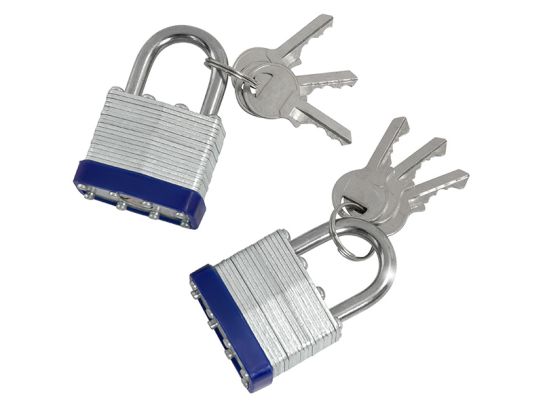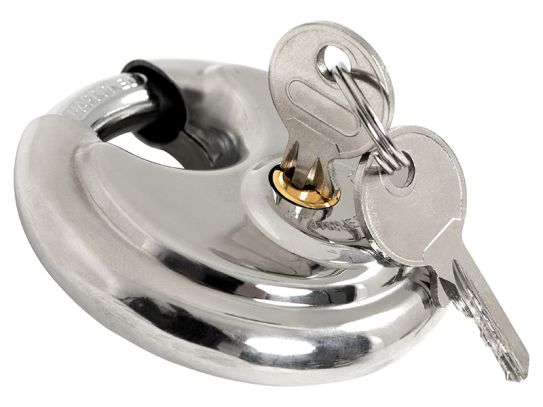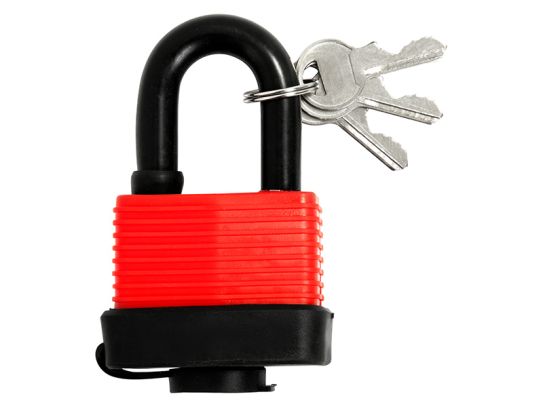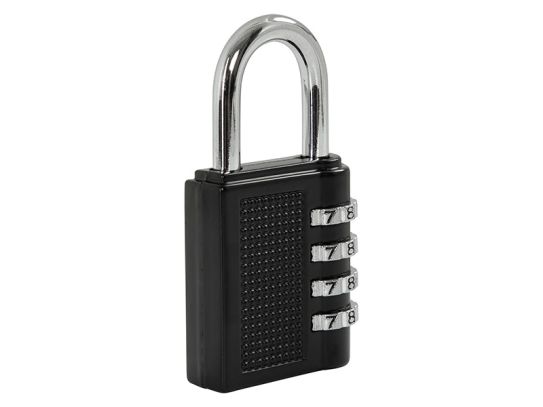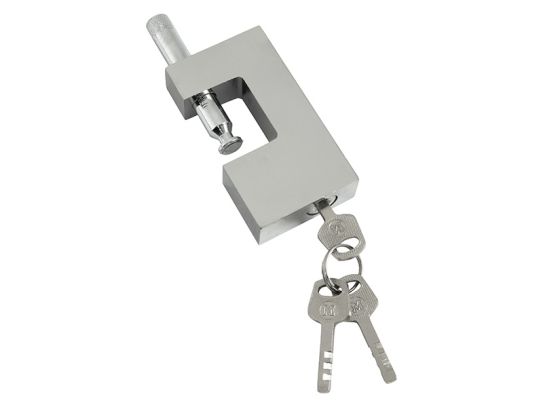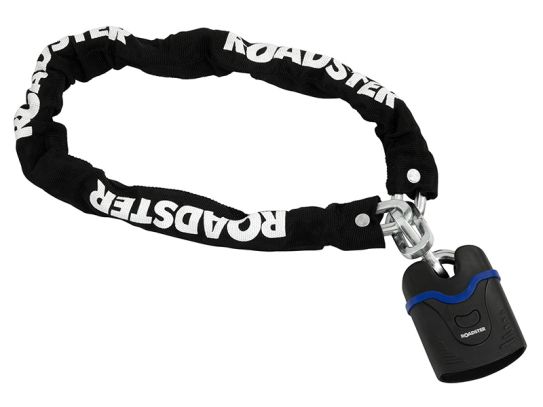Padlocks
Introducing our range of reinforced padlocks - made with hardened steel shackles and reinforced bodies, these padlocks are built to withstand even the toughest attempts at cutting and breaking. With weather-resistant materials, seals and coatings, these padlocks will keep your valuables protected no matter the conditions.
Padlocks That Are Built to Last
Unlock the power of security with our superior range of padlocks. Whether you're looking for durability, versatility, or weather resistance, we've got you covered. Our brass padlocks offer a classic look and unbeatable strength, while our combination padlocks provide added convenience and ease of use. For added protection, our laminated and all weather padlocks are designed to withstand the toughest conditions. And for added flexibility, our chain and cable padlocks are perfect for securing large equipment or multiple items at once. Trust us to keep your workplace secure and protected.
What Are Padlocks?
A padlock is a type of lock that consists of a shackle, which is a U-shaped metal loop that is used to fasten the lock to an object, and a locking mechanism, which is typically a key or combination. Padlocks are often used to secure items such as gates, doors, sheds, lockers, and more. They are typically small and portable, making them easy to use and transport. Padlocks are also commonly used in outdoor and industrial settings, as they are often more durable and weather-resistant than other types of locks.
What Are Some Common Uses for Padlocks?
Padlocks are commonly used for a variety of purposes, some of the most common uses include:
- Locking gates and doors: Padlocks can be used to secure gates, doors, and other entry points to a property, such as a fence or gate, to prevent unauthorised access.
- Securing storage: Padlocks can be used to secure storage containers, such as sheds, lockers, and storage units.
- Locking vehicles: Padlocks can be used to secure vehicles, such as trailers, trucks, and boats, to prevent theft.
- Industrial and construction use: Padlocks can be used to secure equipment, tools, and other valuable items on construction sites and industrial facilities.
- Locking bicycles and motorcycles: Padlocks can be used to secure bicycles and motorcycles, preventing them from being stolen.
- Locking mailboxes: Padlocks can be used to secure mailboxes in order to prevent mail theft.
- Locking animal enclosures: Padlocks can be used to secure animal enclosures, such as chicken coops and dog kennels, to prevent animals from escaping or predators from entering.
What Are the Different Types of Padlocks?
There are several different types of padlocks available, each with their own unique features and benefits. Some of the most common types include:
- Keyed padlocks: These padlocks are opened with a key, which is inserted into the lock's cylinder and turned to release the shackle.
- Combination padlocks: These padlocks are opened by inputting a specific combination into a dial or digital keypad.
- Discus padlocks: These padlocks have a round, disc-shaped locking mechanism, which makes them resistant to drilling and cutting.
- Laminated padlocks: These padlocks have multiple layers of metal, making them more difficult to break or cut through.
- Weatherproof padlocks: These padlocks are designed to withstand extreme weather conditions, such as rain, snow, and heat.
- Cable padlocks: These padlocks have a flexible cable instead of a traditional shackle, making them ideal for securing bicycles, motorcycles and other items.
- Chain padlocks: These padlocks have a chain as the shackle, they are often used to secure large equipment or multiple items at once.
- Electronic padlocks: These padlocks are opened using a code, proximity card or Bluetooth using a smartphone.
- Smart Padlocks: These padlocks are connected to the internet, and can be controlled remotely or via an app, They can also provide access logs, tamper alerts and other features.
What Are the Key Features to Consider When Choosing Padlocks?
When choosing padlocks, there are several key features to consider in order to ensure that the padlock is suitable for your specific needs and requirements. Some of the most important features to consider include:
- Security: The level of security provided by a padlock is one of the most important factors to consider. Look for padlocks that are made from high-quality materials and have strong, durable mechanisms.
- Type of lock: Keyed padlocks, combination padlocks and electronic padlocks are some of the most common types. Consider what type of lock will be most convenient for you to use.
- Weather resistance: If you need a padlock that can withstand extreme weather conditions, look for padlocks that are specifically designed to be weatherproof.
- Size and weight: Consider the size and weight of the padlock, as well as the size and weight of the item that you will be securing. Larger, heavier padlocks are more difficult to cut or break, but they can also be more cumbersome to use.
- Key or combination control: Consider how you want to open the padlock, whether it's with a key or a combination, also if you want a keyed padlock, consider how many keys you need and if it's possible to rekey or order extra keys.
- Brand and reputation: Consider the brand and reputation of the padlock manufacturer, as well as the lock's warranty, to ensure that you are getting a high-quality product that you can trust.
- Smart features: If you are looking for a smart padlock, consider the features that are important to you, such as remote access, access logs, tamper alerts and others.
What Is the Most Secure Type of Padlock?
The most secure type of padlock is subjective and can depend on a number of factors such as the intended use, the environment and the level of security required. However, padlocks that have a higher level of security typically have features such as:
- Hardened steel shackles: These are more resistant to cutting and sawing
- Reinforced bodies: Padlocks with thicker and reinforced bodies are more difficult to break or pry open.
- Multiple locking mechanisms: Some padlocks have multiple locking points, making them more difficult to open.
- Smart Padlocks: these padlocks can have smart features such as tamper alerts, remote access and access logs which can increase the security level of the padlock.
- High-Security Padlocks: Some padlocks are specifically designed for high-security applications, these padlocks can have additional features such as restricted keyways, patented key control and more complex locking mechanisms.
It's also important to note that padlocks that are exposed to the outside elements may require more maintenance than padlocks that are used indoors.
It's important to note that no padlock is 100% unbreakable, but choosing a padlock with several security features can make it more difficult for someone to break it open.
Can I Use a Padlock Outside?
Yes, you can use a padlock outside. However, it's important to consider the environmental conditions that the padlock will be exposed to. If the padlock will be exposed to extreme weather conditions such as rain, snow, and heat, it's important to choose a padlock that is specifically designed to be weather-resistant. These padlocks typically have features such as:
- Weather-resistant materials: such as stainless steel or aluminium, that can withstand harsh environments.
- Weather-resistant seals: These help keep moisture and debris out of the lock's internal mechanisms, prolonging its lifespan.
- Weather-resistant coatings: These coatings can protect the padlock from rust and corrosion.
- Smart Padlocks: Some smart padlocks have weather-resistant features, such as IP rating, which indicates the level of protection the padlock has against dust and water.
It's also worth considering the location, if the padlock is placed in an area where it is frequently exposed to salt water or air, it's recommended to choose a padlock that is resistant to corrosion.
Are There Any UK or European Industry Standards or Regulations That Apply to Padlocks?
Yes, there are several industry standards and regulations that apply to padlocks in the UK and Europe. Some of the most relevant standards include:
- BS EN12320: This is a European standard that applies to padlocks and padlock fittings. It specifies the requirements and test methods for padlocks and their components, such as shackles, bodies and locking mechanisms.
- CE marking: This is a marking that indicates that a product complies with the relevant EU health, safety, and environmental protection regulations. Padlocks that are sold in the EU must bear the CE marking.
- EN 1303: This is a European standard that specifies the requirements and test methods for the mechanical properties of cylinder locks and padlocks.
These standards and regulations are designed to ensure that padlocks meet certain performance and safety requirements, and to help consumers make informed purchasing decisions. It's important to check the padlock you choose to make sure it complies with the relevant standards for your area.
